






Christ Church in Short Hills is blessed with beautiful buildings and lovely grounds and gardens. From the first chapel built in the late 1800’s on land donated by Stewart Hartshorn, through decades of expansion and care; we strive to be good stewards of this church and its tree-lined campus from generation to generation.
We are so grateful for this tree map which documents the beauty and wide diversity of trees on the church grounds. It is a living symbol of the larger commitment of the church to be ecologically aware, to preserve the abundance of nature around us, to protect our resources through a long-term plan for sustainability and to be mindful of the impact of our actions on the environment.
We thank Tom Bredlau, Eagle Scout, for creating this map and appreciate the long tradition of scouting in Millburn and Short Hills. Today, there are more than 150 trees on the church grounds.
This map invites the community to visit our campus and serves as an opportunity to appreciate the rich diversity of trees on the property.
We welcome you!



Christ Church has 175 trees on its grounds tagged with small, metal tree safe tags. As part of this eagle scout project, and with the help of a local arborist, Jody Huxter, we have identified approximately 50 types of trees.
This tree walk intends to highlight some of the trees closest to the church’s main building as examples of some of the variety of species.
Turning left out of the main door of the church, the first tree is located on the front lawn. The tree walk continues counter clockwise around the back of the church.
Each tree has a page in the book, which includes the metal tag number for reference.
A short passage with basic information about each tree is included and a QR code for additional information.
It is our hope that you enjoy this brief walk and the church’s trees.

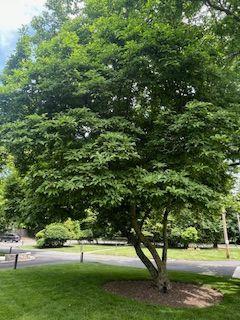
The Saucer Magnolia (Magnolia × soulangeana) is a hybrid tree created in 1820 by a retired cavalry officer from Napoleon’s army. It is an extremely common magnolia in France and is also very popular on the East Coast of the United States. This type of magnolia has blooms, ranging from white and pink to maroon. Magnolias’ flowers attract various pollinators- including beetles- contributing to biodiversity.


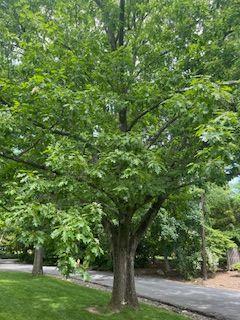
Red oak (Quercus rubra) is a native tree prized for its robust wood and striking red fall foliage. Typically reaching heights of 60 to 75 feet, it has a broad, rounded crown and leaves with 7 to 11 pointed lobes. Red Oaks’ acorns are an important food source for wildlife, including deer, squirrels, and birds.



Sweetgum (Liquidambar styraciflua) is a native tree, known for its star-shaped leaves and distinctive spiky seed balls. Reaching heights of 60 to 100 feet, sweetgum trees have a straight trunk and a pyramidal crown when young, becoming more rounded with age. The leaves turn vibrant shades of red, orange, yellow, and purple in the fall. The tree’s resin, historically known as "liquid amber," has been used for medicinal and aromatic purposes.


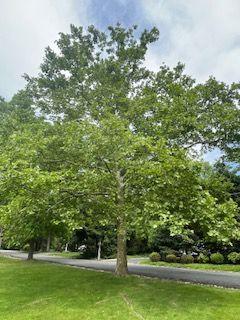
Sycamore (Platanus occidentalis), also known as American sycamore or buttonwood, is a large native tree renowned for its massive size, reaching heights of 75 to 100 feet or more. Its bark peels away and reveals white, tan, and green wood beneath. Sycamores have broad leaves with three to five lobes and produce round, fuzzy seed balls that hang from the branches throughout the winter. Sycamores play an important ecological role, providing habitat and food for various wildlife.


The tulip tree (Liriodendron tulipifera), also known as yellow poplar or tulip poplar, is a native tree. In late spring it has tulipshaped, greenish-yellow flowers. Some say its unique leaves look like a cat's face, particularly in fall when they turn orange..
Tulip trees are essential for wildlife, providing nectar for pollinators like bees and hummingbirds, and serving as a host plant for the larvae of the eastern tiger swallowtail butterfly.

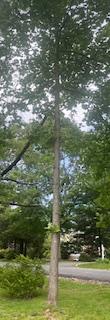


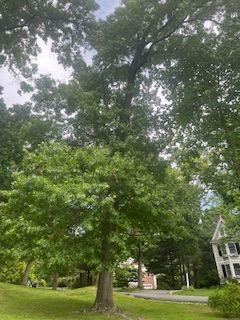
The pin oak (Quercus palustris) is a native tree. It has a unique growth pattern with lower branches that tend to droop, middle branches that grow horizontally, and upper branches that ascend into the sky. Reaching heights of 60 to 70 feet, pin oaks have lobed leaves that turn scarlet in the fall.

The tree produces small, round acorns that are an important food source for deer, squirrels, and birds. Pin oaks have a fast growth rate and tolerance to pollution.

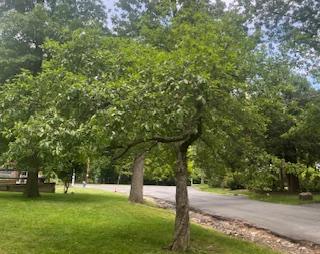
The Crab apple (Malus spp.) is a small, native tree known for its pretty fragrant flowers and small, colorful fruit. Crab apples typically reach heights of 15 to 25 feet. In spring, they produce white, pink, or red blooms, which are followed by small, round yellow and red fruits. These fruits, while often too tart for humans to eat raw, are excellent for making jellies, jams, and cider.The trees are also valued for providing food and habitat for various birds and wildlife. Crab apple trees are resistant to disease and pests.


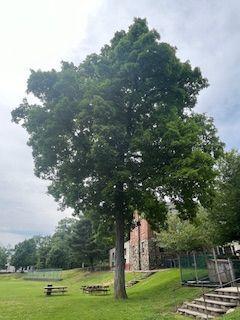
Shagbark hickory (Carya ovata) is a native tree.. It can be identified by its distinctive shaggy bark that peels away in long strips. Growing to heights of 60 to 80 feet, it has an oval-shaped crown and leaves with five leaflets that turn golden yellow in fall.
The tree produces sweet, edible nuts that are a valuable food source for wildlife and can also be consumed by humans. In fact, some people use hickory nuts in their pecan pie recipes with success!



The eastern white pine (Pinus strobus) is a native evergreen conifer, known for its tall stature, soft, flexible needles, and graceful form. Towering to heights of 50 to 80 feet or more, with a straight trunk and pyramidal crown, it is often considered the largest pine species in our region. The tree's slender needles grow in bundles of five and remain green throughout the year, providing year-round beauty.
Eastern white pines play a vital ecological role, providing habitat for various wildlife species and helping stabilize soil and prevent erosion.


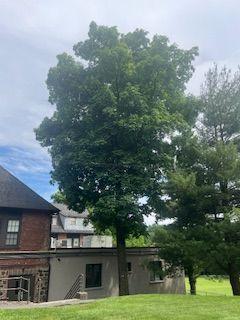
The pignut hickory (Carya glabra) is a native tree, recognized for its small, pear-shaped nuts that serve as a food source for wildlife. Growing to heights of 50 to 80 feet, it features a straight trunk and a rounded crown. Pignut hickories have five leaflets per leaf and these turn yellow in the fall.

The bitter nuts of the pignut hickory are not typically consumed by humans, but they are an important food source for squirrels, deer, and other wildlife.

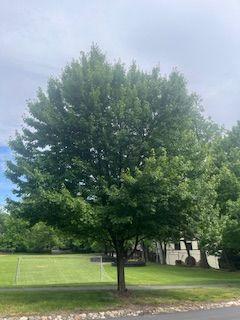
Sugar maple (Acer saccharum) is a native tree, known for its vibrant fall foliage and sap, which is the primary source of maple syrup.
Reaching heights of up to 75 feet, it features a dense, rounded crown and five-lobed leaves that turn brilliant shades of orange, red, and yellow in fall. They play a crucial ecological role, providing habitat and food for various wildlife.




Norway maple (Acer platanoides) is found in Europe and western Asia, but has been widely planted as in North America. Recognized for its lobed leaves with pointed tips, it typically grows to 40 -50 feet. Norway maples produce small, yellow flowers in spring, followed by winged seeds known as samaras.
Norway maples remains a popular choice for urban landscaping and street planting due to their tolerance of urban conditions, such as pollution and compacted soil.

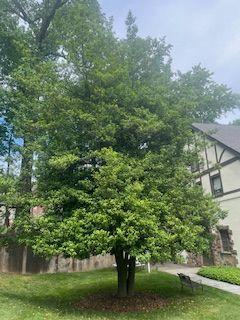
Holly shrubs and trees have over 400 species worldwide. These plants are characterized by their glossy, leathery leaves and often vibrant red berries, which persist through the winter months, adding color to the landscape. Holly species vary widely in size, from small shrubs to tall trees, and are valued for their significance in holiday traditions. In addition to their aesthetic appeal, hollies provide habitat and food for birds and other wildlife.


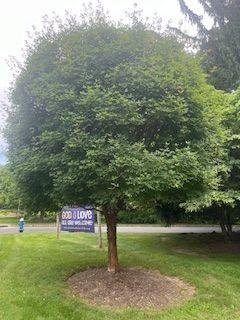
The paperbark maple (Acer griseum) is a non native tree prized for its attractive peeling cinnamon-colored bark, which reveals a smooth, coppery underlayer. Originating from central China, this small to medium-sized tree typically grows 20 to 30 feet. Its trifoliate leaves turn red and orange in the fall. It is tolerant to urban conditions, slow-growing, and low maintenance.


Thank you to Christ Church and especially Reverend Bowie for giving me this opportunity and helping me through this project.
Many thanks to Georgeann duChossis, the parish administrator for support throughout the project.
Thank you Jody Huxter, arborist, for assisting with identifying the trees on the property and sharing his expertise.
Thank you Troop 17 and the scouts who volunteered to help with this project.
Finally, thank you to my family for encouraging me.
It is my hope to explore having some of Christ Church’s bigger trees, including the Shagbark Hickory, added to the New Jersey Forest Services’ Big Tree Registry ; I would also like to continue working with Christ Church in its journey to become a stage one arboretum.
